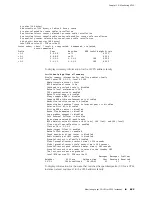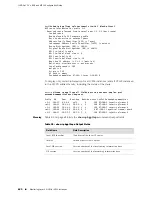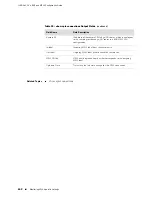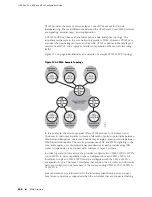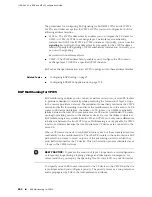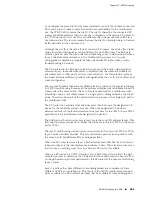
to two different sites configured in the same VPWS instance and on the same PE
router.
BGP advertises reachability for the VPNs. The BGP configuration is similar to that
used for other VPN services, such as layer 3 VPNs and VPLS. MPLS is configured to
set up base LSPs to the remote PE routers similarly to the other VPN services.
BGP Signaling for L2VPNs
When you configure VPWS at a given PE router for a given L2VPN customer, BGP
signals reachability for all sites that belong to that L2VPN. This signaling is identical
to the signaling used for BGP/MPLS VPNs and VPLS. The network layer reachability
information (NLRI) for both services are encoded in a similar manner.
A new NLRI format carries the individual VPWS information listed in Table 100 on
page 647. One or more of these NLRIs is carried in the MP_REACH_NLRI and
MP_UNREACH_NLRI BGP attributes.
Table 100: Components of VPWS NLRI
Size in octets
NLRI value
2
Length
8
Route Distinguisher
2
CE-ID
2
Label-block Offset
3
Label Base
0–
n
Variable TLVs
The local PE router selects a contiguous label block to cover all the remote sites for
a given VPWS instance. The local PE router then advertises that label block as part
of the reachability information for a given CE device in a particular VPWS instance;
(the NLRI contains the CE-ID (site ID) for the CE device. This label block represents
the set of demultiplexers that are used to cross-connect incoming MPLS traffic to a
specific local interface in the VPWS instance..
The local PE router also processes advertisements from all remote PE routers and
for each local interface in an VPWS instance. The local PE router selects a
demultiplexer label from a label block received from the remote PE router associated
with each remote site in the VPWS instance. Traffic coming into the local interface
from the CE device is cross-connected to an MPLS next hop that corresponds to the
demultiplexer. Traffic is then encapsulated in MPLS and sent across the MPLS core
to the remote PE router in the L2VPN.
The same address family identifier (AFI) and subsequent address family identifier
(SAFI) are used in the NLRI for VPWS and VPLS.
BGP Signaling for L2VPNs
■
647
Chapter 12: VPWS Overview
Summary of Contents for BGP
Page 6: ...vi ...
Page 8: ...viii JUNOSe 11 1 x BGP and MPLS Configuration Guide ...
Page 37: ...Part 1 Border Gateway Protocol Configuring BGP Routing on page 3 Border Gateway Protocol 1 ...
Page 38: ...2 Border Gateway Protocol JUNOSe 11 1 x BGP and MPLS Configuration Guide ...
Page 234: ...198 Monitoring BGP JUNOSe 11 1 x BGP and MPLS Configuration Guide ...
Page 236: ...200 Multiprotocol Layer Switching JUNOSe 11 1 x BGP and MPLS Configuration Guide ...
Page 542: ...506 Monitoring BGP MPLS VPNs JUNOSe 11 1 x BGP and MPLS Configuration Guide ...
Page 544: ...508 Layer 2 Services Over MPLS JUNOSe 11 1 x BGP and MPLS Configuration Guide ...
Page 610: ...574 Virtual Private LAN Service JUNOSe 11 1 x BGP and MPLS Configuration Guide ...
Page 624: ...588 VPLS References JUNOSe 11 1 x BGP and MPLS Configuration Guide ...
Page 680: ...644 Virtual Private Wire Service JUNOSe 11 1 x BGP and MPLS Configuration Guide ...
Page 724: ...688 Monitoring MPLS Forwarding Table for VPWS JUNOSe 11 1 x BGP and MPLS Configuration Guide ...
Page 725: ...Part 6 Index Index on page 691 Index 689 ...
Page 726: ...690 Index JUNOSe 11 1 x BGP and MPLS Configuration Guide ...

